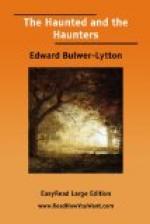“January 13, 1665.—At sunrise I was again in the field. She came in at once, and, as it seemed, with freedom. Inquired if she knew my thoughts, and what I was going to relate? Answered, ’Nay, we only know what we perceive and hear; we cannot see the heart.’ Then I rehearsed the penitent words of the man she had come up to denounce, and the satisfaction he would perform. Then said she, ‘Peace in our midst.’ I went through the proper forms of dismissal, and fulfilled all as it was set down and written in my memoranda; and then, with certain fixed rites, I did dismiss that troubled ghost, until she peacefully withdrew, gliding towards the west. Neither did she ever afterward appear, but was allayed until she shall come in her second flesh to the valley of Armageddon on the last day.”
These quaint and curious details from the “diurnal” of a simple-hearted clergyman of the seventeenth century appear to betoken his personal persuasion of the truth of what he saw and said, although the statements are strongly tinged with what some may term the superstition, and others the excessive belief, of those times. It is a singular fact, however, that the canon which authorises exorcism under episcopal licence is still a part of the ecclesiastical law of the Anglican Church, although it might have a singular effect on the nerves of certain of our bishops if their clergy were to resort to them for the faculty which Parson Rudall obtained. The general facts stated in his diary are to this day matters of belief in that neighbourhood; and it has been always accounted a strong proof of the veracity of the Parson and the Ghost, that the plague, fatal to so many thousands, did break out in London at the close of that very year. We may well excuse a triumphant entry, on a subsequent page




